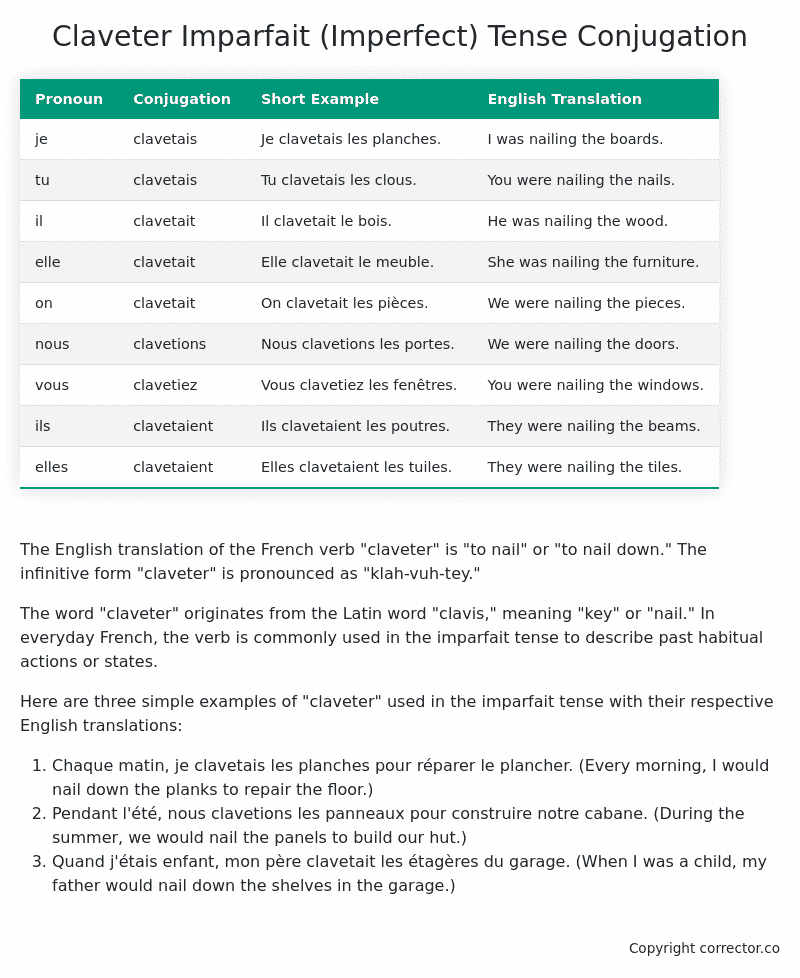Imparfait (Imperfect) Tense Conjugation of the French Verb claveter
Introduction to the verb claveter
The English translation of the French verb “claveter” is “to nail” or “to nail down.” The infinitive form “claveter” is pronounced as “klah-vuh-tey.”
The word “claveter” originates from the Latin word “clavis,” meaning “key” or “nail.” In everyday French, the verb is commonly used in the imparfait tense to describe past habitual actions or states.
Here are three simple examples of “claveter” used in the imparfait tense with their respective English translations:
- Chaque matin, je clavetais les planches pour réparer le plancher. (Every morning, I would nail down the planks to repair the floor.)
- Pendant l’été, nous clavetions les panneaux pour construire notre cabane. (During the summer, we would nail the panels to build our hut.)
- Quand j’étais enfant, mon père clavetait les étagères du garage. (When I was a child, my father would nail down the shelves in the garage.)
Table of the Imparfait (Imperfect) Tense Conjugation of claveter
| Pronoun | Conjugation | Short Example | English Translation |
|---|---|---|---|
| je | clavetais | Je clavetais les planches. | I was nailing the boards. |
| tu | clavetais | Tu clavetais les clous. | You were nailing the nails. |
| il | clavetait | Il clavetait le bois. | He was nailing the wood. |
| elle | clavetait | Elle clavetait le meuble. | She was nailing the furniture. |
| on | clavetait | On clavetait les pièces. | We were nailing the pieces. |
| nous | clavetions | Nous clavetions les portes. | We were nailing the doors. |
| vous | clavetiez | Vous clavetiez les fenêtres. | You were nailing the windows. |
| ils | clavetaient | Ils clavetaient les poutres. | They were nailing the beams. |
| elles | clavetaient | Elles clavetaient les tuiles. | They were nailing the tiles. |
Other Conjugations for Claveter.
Le Present (Present Tense) Conjugation of the French Verb claveter
Imparfait (Imperfect) Tense Conjugation of the French Verb claveter (You’re reading it right now!)
Passé Simple (Simple Past) Tense Conjugation of the French Verb claveter
Passé Composé (Present Perfect) Tense Conjugation of the French Verb claveter
Futur Simple (Simple Future) Tense Conjugation of the French Verb claveter
Futur Proche (Near Future) Tense Conjugation of the French Verb claveter
Plus-que-parfait (Pluperfect) Tense Conjugation of the French Verb claveter
Passé Antérieur (Past Anterior) Tense Conjugation of the French Verb claveter
Futur Antérieur (Future Anterior) Tense Conjugation of the French Verb claveter
Subjonctif Présent (Subjunctive Present) Tense Conjugation of the French Verb claveter
Subjonctif Passé (Subjunctive Past) Tense Conjugation of the French Verb claveter
Subjonctif Imparfait (Subjunctive Imperfect) Tense Conjugation of the French Verb claveter
Subjonctif Plus-que-parfait (Subjunctive Pluperfect) Tense Conjugation of the French Verb claveter
Conditionnel Présent (Conditional Present) Tense Conjugation of the French Verb claveter
Conditionnel Passé (Conditional Past) Tense Conjugation of the French Verb claveter
Conditionnel Passé II (Conditional Past II) Tense Conjugation of the French Verb claveter
L’impératif Présent (Imperative Present) Tense Conjugation of the French Verb claveter
L’impératif Passé (Imperative Past) Tense Conjugation of the French Verb claveter
L’infinitif Présent (Infinitive Present) Tense Conjugation of the French Verb claveter
L’infinitif Passé (Infinitive Past) Tense Conjugation of the French Verb claveter
Le Participe Présent (Present Participle) Tense Conjugation of the French Verb claveter
Le Participe Passé (Past Participle) Tense Conjugation of the French Verb claveter
Struggling with French verbs or the language in general? Why not use our free French Grammar Checker – no registration required!
Get a FREE Download Study Sheet of this Conjugation 🔥
Simply right click the image below, click “save image” and get your free reference for the claveter imparfait tense conjugation!

Claveter – About the French Imparfait Tense
NOTE: To take a deep dive into all the French tenses then see our article on Mastering French Tense Conjugation.
Formation of the Imparfait Tense
For regular -er verbs:
For regular -ir verbs
For regular -re verbs
Common Everyday Usage Patterns
Description of Past Habits
Background Information
Mental and Emotional States
It’s employed to express emotions, thoughts, or physical sensations in the past. For example: “J’étais content quand il est arrivé.” (I was happy when he arrived.)
Ongoing Actions
Points to Note About the Imparfait Tense
Passé Composé vs. Imparfait
Conditional
Si Clauses
Narration
I hope you enjoyed this article on the verb claveter. Still in a learning mood? Check out another TOTALLY random French verb imparfait conjugation!


